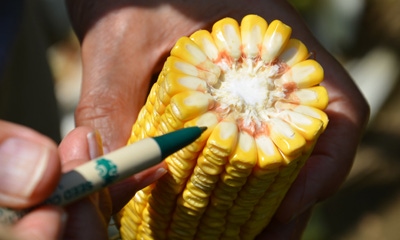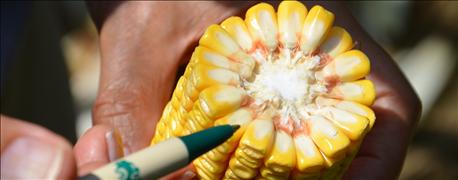
Suppose you estimated corn yields in late August. When you harvest the field, yields aren’t as high as you estimated. Why not?
Dave Nanda notes there could be several explanations. However, one likely cause could be overestimating kernel depth and size. That enters the yield estimation formula when you choose the kernel size factor to divide by to get final yield results.
Nanda is a plant breeder and crops consultant for Seed Consultants Inc., sponsor of Crop Watch ’16. Both genetics of the hybrid and weather during the grain fill period help determine kernel size.

KERNEL DEPTH MATTERS: You can get a better idea of how corn with ears like this one might yield if you break an ear in half and examine kernel depth and size.
When the Purdue University Corn and Soybean Field Guide was first issued more than a decade ago, the kernel size factor used was 90. With modern genetics, some people now suggest using a number as small as 75. Still others use either 80 or 85, depending on the season and hybrid. The bigger the kernels, the smaller the factor you should select. The smaller the factor, the higher the yield estimate will be.
How it works
The yield estimation formula boils down to average number of kernel rows per ear times average kernels per row times ears per acre. Many people originally used stalks per acre, but most agronomists believe it’s most accurate to count ears per acre in 1/1000 acre, and use that nomenclature.
Typically after counting the number of ears in that acreage, which is 17 feet, 5 inches of a row in 30-inch rows, one picks three ears at random, and counts both number of kernel rows around on each ear, and number of kernels per row. Then these numbers are averaged together to get one row number and one kernel per row number. If the yield check is repeated at several spots, all these numbers are averaged together to get an average number of rows and average number of kernels per row to use in the yield formula.
Here is an example from one location in the Crop Watch ’16 field, where two rows were sampled. There was an average of 28 ears per check, representing 28,000 ears per acre, 16 rows per ear and 36 kernels per row. If you use a kernel size factor of 80, the formula is: 28 ears times 16 rows times 36 kernels per row equals 16,128 divided by 80 equals 201.6 bushels per acre.
Kernel factor
You’ve heard the expression "figures don’t lie, but liars figure." You don’t have to be a liar to come up with a different yield estimate. You just have to use a different factor for kernel size and depth, Nanda notes.
Suppose you’re old-fashioned and think kernels will be small. You use the factor of 90. Now the estimate is 179.2 bushels per acre. Maybe you’re a pessimist, but not quite that pessimistic. You use a factor of 85. The new yield estimate is 190 bushels per acre.
Or maybe you’re an eternal optimist. You pick 75 for the factor. You’re expecting 215 bushels per acre. That’s a range of over 35 bushels per acre depending upon which factor you choose.
In the end, of course, the yield monitor has the final say, Nanda emphasizes.
About the Author(s)
You May Also Like




